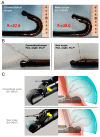Dedicated Echoendoscope for Interventional Endoscopic Ultrasound: Comparison with a Conventional Echoendoscope
- PMID: 38792381
- PMCID: PMC11121945
- DOI: 10.3390/jcm13102840
Dedicated Echoendoscope for Interventional Endoscopic Ultrasound: Comparison with a Conventional Echoendoscope
Abstract
Background/Objective: Interventional endoscopic ultrasound (I-EUS) is technically difficult and has risks of severe adverse events due to the scarcity of dedicated endoscopes and tools. A new EUS scope was developed for I-EUS and was modified to increase the puncture range, reduce the blind area, and overcome guidewire difficulties. We evaluated the usefulness and safety of a new EUS scope compared to a conventional EUS scope. Methods: All I-EUS procedures were performed at Juntendo University Hospital from April 2020 to April 2022. The primary outcomes included the procedure time and fluoroscopy time. The secondary outcomes included the technical success rate and the rates of procedure-related adverse events. Clinical data were retrospectively reviewed and statistically analyzed between the new and conventional EUS scopes. Results: In total, 143 procedures in 120 patients were analyzed. The procedure time was significantly shorter with the new EUS scope, but the fluoroscopy time was not different. Among the patients only undergoing EUS-guided biliary drainage (EUS-BD), 79 procedures in 74 patients were analyzed. Both the procedure time and fluoroscopy time were significantly shorter with the new EUS scope. Multivariate analysis revealed that a new EUS scope and use of covered metal stents could reduce the fluoroscopy time. The technical success rate and the adverse event rate were not significantly different between the total I-EUS and the EUS-BD only groups. However, the conventional scope showed stent deviation during stent placement, which did not happen with the new scope. Conclusions: The new EUS scope reduced procedure time for total I-EUS and fluoroscopy time for EUS-BD compared to a conventional EUS scope because of the improvement suitable for I-EUS.
Keywords: EUS-guided biliary drainage (EUS-BD); adverse events; endoscopic ultrasound (EUS); fluoroscopy time; interventional EUS.
Conflict of interest statement
Nakai received a research grant from Fujifilm Corporation, and lecture fees from Fujifilm Corporation, Olympus Corporation, and Boston Scientific Japan. Isayama received research grants from Fujifilm Corporation and Boston Scientific Japan, and lecture fees from Fujifilm Corporation, Century Medical Corporation, and Boston Scientific Japan.
Figures


Similar articles
-
Clinical utility of treatment method conversion during single-session endoscopic ultrasound-guided biliary drainage.World J Gastroenterol. 2020 Mar 7;26(9):947-959. doi: 10.3748/wjg.v26.i9.947. World J Gastroenterol. 2020. PMID: 32206005 Free PMC article.
-
Utility of Endoscopic Ultrasound-Guided Hepaticogastrostomy with Antegrade Stenting for Malignant Biliary Obstruction after Failed Endoscopic Retrograde Cholangiopancreatography.Oncology. 2017;93 Suppl 1:69-75. doi: 10.1159/000481233. Epub 2017 Dec 20. Oncology. 2017. PMID: 29258066
-
EUS-guided biliary interventions for benign diseases and unsuccessful ERCP - a prospective unicenter feasibility study on a large consecutive patient cohort.Z Gastroenterol. 2021 Sep;59(9):933-943. doi: 10.1055/a-1540-7975. Epub 2021 Sep 10. Z Gastroenterol. 2021. PMID: 34507372 English.
-
Lumen-apposing-metal stent misdeployment in endoscopic ultrasound-guided drainages: A systematic review focusing on issues and rescue management.World J Gastroenterol. 2023 Jun 7;29(21):3341-3361. doi: 10.3748/wjg.v29.i21.3341. World J Gastroenterol. 2023. PMID: 37377584 Free PMC article.
-
Endoscopic ultrasound-guided biliary drainage-current status and future perspectives.World J Gastrointest Endosc. 2021 Dec 16;13(12):607-618. doi: 10.4253/wjge.v13.i12.607. World J Gastrointest Endosc. 2021. PMID: 35070022 Free PMC article. Review.
Cited by
-
Development of a Dedicated X-Ray Fluoroscopic Apparatus for Therapeutic Pancreatobiliary Endoscopy: A Review.J Clin Med. 2025 Feb 12;14(4):1214. doi: 10.3390/jcm14041214. J Clin Med. 2025. PMID: 40004745 Free PMC article. Review.
-
Clinical evaluation of a novel fluoroscopic mode for improving visibility during interventional endoscopic ultrasound (with video).Therap Adv Gastroenterol. 2025 Jun 27;18:17562848251349595. doi: 10.1177/17562848251349595. eCollection 2025. Therap Adv Gastroenterol. 2025. PMID: 40583971 Free PMC article.
References
-
- Gopakumar H., Singh R.R., Revanur V., Kandula R., Puli S.R. Endoscopic Ultrasound–Guided vs Endoscopic Retrograde Cholangiopancreatography–Guided Biliary Drainage as Primary Approach to Malignant Distal Biliary Obstruction: A Systematic Review and Meta-Analysis of Randomized Controlled Trials. Am. J. Gastroenterol. 2024 doi: 10.14309/ajg.0000000000002736. Online ahead of print . - DOI - PubMed
-
- Isayama H., Nakai Y., Itoi T., Yasuda I., Kawakami H., Ryozawa S., Kitano M., Irisawa A., Katanuma A., Hara K., et al. Clinical practice guidelines for safe performance of endoscopic ultrasound/ultrasonography-guided biliary drainage: 2018. J. Hepato-Biliary-Pancreatic Sci. 2019;26:249–269. doi: 10.1002/jhbp.631. - DOI - PMC - PubMed
Grants and funding
LinkOut - more resources
Full Text Sources
Miscellaneous

